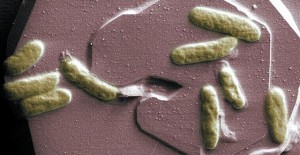In a joint project between the UK’s University of East Anglia (UEA) and the Pacific Northwest National Laboratory (PNNL) in Washington State (US) researchers have published a paper about their work utilizing bacteria to produce electric currents in batteries. From the Mar. 25, 2013 news item on ScienceDaily,
Scientists at the University of East Anglia have made an important breakthrough in the quest to generate clean electricity from bacteria.
Findings published today in the journal Proceedings of the National Academy of Sciences (PNAS) show that proteins on the surface of bacteria can produce an electric current by simply touching a mineral surface.
The research shows that it is possible for bacteria to lie directly on the surface of a metal or mineral and transfer electrical charge through their cell membranes. This means that it is possible to ‘tether’ bacteria directly to electrodes — bringing scientists a step closer to creating efficient microbial fuel cells or ‘bio-batteries’.
The team collaborated with researchers at Pacific Northwest National Laboratory in Washington State in the US.
Shewanella oneidensis (pictured) is part of a family of marine bacteria. The research team created a synthetic version of this bacteria using just the proteins thought to shuttle the electrons from the inside of the microbe to the rock.

Image: Shewanella oneidensis bacteria, Alice Dohnalkova. (downloaded from http://www.uea.ac.uk/mac/comm/media/press/2013/March/bio-batteries)
The Mar. 25, 2013 UEA news release,which originated the news item, describes the work n some detail (Note: A link has been removed),
They inserted these proteins into the lipid layers of vesicles, which are small capsules of lipid membranes such as the ones that make up a bacterial membrane. Then they tested how well electrons travelled between an electron donor on the inside and an iron-bearing mineral on the outside.
Lead researcher Dr Tom Clarke from UEA’s school of Biological Sciences said: “We knew that bacteria can transfer electricity into metals and minerals, and that the interaction depends on special proteins on the surface of the bacteria. But it was not been clear whether these proteins do this directly or indirectly though an unknown mediator in the environment.
“Our research shows that these proteins can directly ‘touch’ the mineral surface and produce an electric current, meaning that is possible for the bacteria to lie on the surface of a metal or mineral and conduct electricity through their cell membranes.
“This is the first time that we have been able to actually look at how the components of a bacterial cell membrane are able to interact with different substances, and understand how differences in metal and mineral interactions can occur on the surface of a cell.
“These bacteria show great potential as microbial fuel cells, where electricity can be generated from the breakdown of domestic or agricultural waste products.
“Another possibility is to use these bacteria as miniature factories on the surface of an electrode, where chemicals reactions take place inside the cell using electrical power supplied by the electrode through these proteins.”
Biochemist Liang Shi of Pacific Northwest National Laboratory said: “We developed a unique system so we could mimic electron transfer like it happens in cells. The electron transfer rate we measured was unbelievably fast – it was fast enough to support bacterial respiration.”
This work reminds me of the biobattery created at Concordia University (my April 20, 2012 posting) and the work on breathable batteries at the Polish Academy of Sciences (my Mar. 8, 2013 posting).
Interested parties can find a full citation for the UEA/PNNL research paper at the bottom of the ScienceDaily news item here.